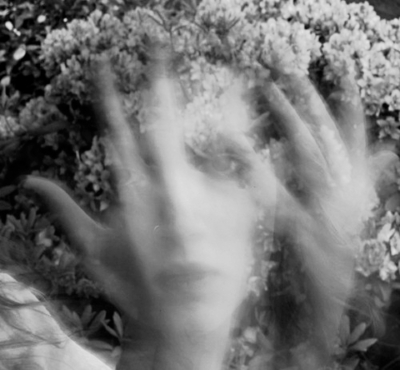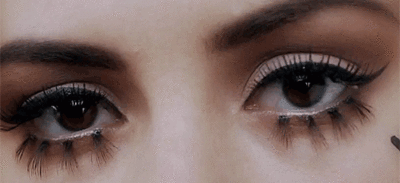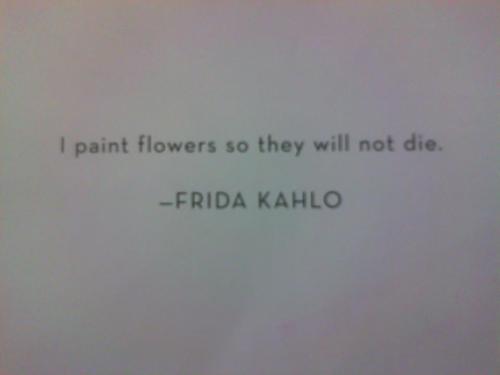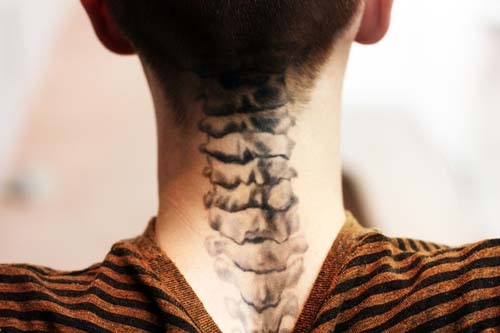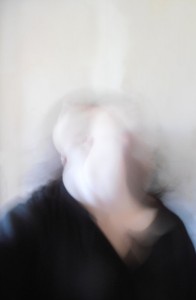from Projecting Questions? (Toronto: Art Gallery of York University, 2009)
you can buy a copy for yourself here: http://www.yorku.ca/agyu/archive/archive/p2009_hoolboom.html
“Last night I had a dream about my father. He was very old with sad dark eyes that seemed haunted by the truth he was about to discover. He’d turned our basement into a crazy kind of science lab with test tubes and machines everywhere, designed to make new human beings. He was muttering to himself that the body has openings to admit the world, the ears for hearing, the eyes for sight, but he was making a body whose entire surface would be an opening. He was making a body that couldn’t keep the outside outside, a body that said yes to everything.
And then I saw who he was making, and realized I was watching for the first time the circumstances of my own birth.” Imitations of Life
This is the manufactured body of the new age. Softened by environmental diseases, our pores no longer withhold the onslaught of life. As an attempt at inoculation, we turn towards the camera’s gaze, beholden to cinema to document the fleetingness of presence. If we can be captured, we will find a place in history and a place in the future. Celebrities become human gods because the future will not forget them. Everyday people, however, can only search for our faces as extras in the image world before us. Our subjectivity is afloat, never represented to us, always fleeting amidst the manufactured gaze.
The short life of the cinema has bridged the age of discovery with the age of industry, and this merger manifests itself in our viewing habits. Cinema is a corporeal, not an abstract art, presenting material images rather than dreams, and so we no longer imagine other worlds. We have an innate urge to see ourselves through fiction, see ourselves through the silver screen. Especially since the introduction of video, we understand the screen as a mirror, and we want to see ourselves reflected in it. A truth emerged from the vicious politics of the cultural wars. We like to identify with what we see. At worst, we view in modular cultures, where festivals, cinemas and television stations celebrate only one point of community, one simple shard of each of our multiple beings—meals cooked for the family, but no guests, please.
Even so, we know intrinsically that the image that we do see is not an accurate likeness. Representation fails. As images become more commodified, we lose our stake in them. While we may have won certain types of representation, we see that type modeled before us as a directive rather than a portrait of who we are. As we adorned ourselves in the commodities we wear on our bodies—becoming representations of what we see on television—our actual skins and bodies become increasingly invisible.
The need to find the invisible man lost in the commodity image. In this barrage of images, where are “we”? The manufacturers have forgotten us. We forget ourselves.
Mike Hoolboom’s The Invisible Man installation tackles this unmoored subjectivity directly, trying to imagine a place for us in a world that pulls towards the generic image, the manufactured images that make us invisible. The loss of self in a swirl of images is a reoccurring narrative in media theory and Hoolboom is equal parts theorist and artist. No one submerges so long within the currents of popular culture without discovering the men behind the curtain and coming up with some conspiracies of their own. Hoolboom has been exploring this terrain for a while as a film and video maker and with The Invisible Man, he situates these conspiracies physically in a gallery show.
Much of the discussion in this volume involves the difference between installation and cinema and what is involved with bringing filmmaker Mike Hoolboom into the gallery environment. In some regards, this parsing is beside the point for Hoolboom’s work. He has always been a modular filmmaker. As both a way to fund his projects and as a method of storytelling, his short films often become chapters in his longer work. Compendiums like Panic Bodies (1998), Imitations of Life (2003), and Public Lighting (2004) incorporate work that has often stood alone for a number of years[i]. Projects from across his history are swallowed up as chapters into his larger pieces. They create accumulations on a theme through digression and counterpoint. Moving this process from the cinema to the gallery is primarily a matter of juxtaposing these modules architecturally rather than solely through time.
With The Invisible Man, pieces from his cinematic works are suspended in space. Three modules are removed from Imitations of Life and paired with three new pieces. The Invisible Man becomes a topography, written across the gallery space. This installation thus becomes a montage based on the direction the viewer moves in space. The work is still in chapters, but body movements draw viewers back and forth, amplifying the work by physical juxtapositions. There are bodies moving between these images, surrounded as if by skin.
Hoolboom has been welcomed into the gallery at a time when the art world has turned to cinema for reference. Ideas of spectatorship are now part of the dialogue, so it is appropriate to turn to Hoolboom, who has spent years trying to construct an audience. Much of that work involves active work on the sales pitch, as a writer, curator and historian of what he calls the fringe—an accurate geographic term for what others label experimental film. However, he does the majority of this work through his art, trying to imagine both his audience and what that audience sees in the images before them.
This attention to spectatorship goes back to his first films from twenty-five years ago. Although he was a peer to the circle of young filmmakers at Sheridan College who became known as the Escarpment School, Hoolboom’s proclivities took him away from their concerns. While friends like Phil Hoffman and Richard Kerr were examining how film manufactures truth, Hoolboom was looking at how film manufactures reception. His eye was tuned to the moment the light transmitted the film frame onto the screen. He was curious about audience and what they took with them when going to the theatre and what they read of themselves when they got there. His film structures were designed for the social. His first film Song for Mixed Choir (1981) assaulted the audience with a shower of grain—figures only begin to emerge from the shadows in the second half of the film. In some ways, this was the birth of the image for Hoolboom. The Big Show (1984) prompted the audience with intertitles and instructions on what to do while watching the film (using both physical directives and imaginative queries). Hoolboom’s attention to the act of sitting in a theatre culminates in The White Museum (1986), thirty minutes of clear leader that ends with a single picture. Along the way his voice-over tells of the various things he would have shot if he had had the money.
It may seem like this work is aggressively trying to turn off an audience, but if you listen or participate, it becomes clear that he is trying to imagine an audience. The voice-over in The White Museum, his voice, invites “a movie house dialogue, half-way between sound and sight, that will leave us a place for our own pictures.” Our place as an audience is there, with him, imagining anew; owning our own pictures with imagination if not money.
Our own pictures. After twenty-five years, Hoolboom has returned repeatedly to try to define his own pictures in the sea of chaos that is contemporary media culture. Since the mid-nineties, when he was diagnosed with HIV, he has taken on the role of becoming a virus in this media culture, stealing the images of Hollywood and television in order to give them new life, as he was blatantly fighting for his own. He interrogates those images, mourning their inability to move beyond surfaces, just as we are often unable to move towards political or social engagement. He continues to imagine an audience, but now he wants to see what the possibilities are. Why does this mass produced cinematic language produce a mass appeal? Why does it also feel so empty? It seemed in some ways like the end of the line. These images, with all the money spent to make them, still had nothing to say.
As many personal filmmakers find the arc of their lives informing their art, Hoolboom’s nephew may have helped him make the transition to his next body of work, the work that culminates in Imitations of Life and the installation The Invisible Man. After having put years into viciously fighting both the virus and his audiences (films that drew the viewer in, like Letters from Home (1996) and Positiv (1997) were balanced by films like House of Pain (1995) that very much pushed the audience away), he must have looked around one day and thought, “hey, I’m still here.” Then his nephew is born. A new life, a new future, and subject for a film (Jack, 2002). How do we look at the future? How do we look at the future when we do not see our own? How do we look at our future through images that do not show us ourselves? Here we are at the story arc that becomes The Invisible Man, the line of thought that started as a compendium film, Imitations of Life and mutated into an installation. The imitations of life that we develop in order to shape our life. The need to find the invisible man lost in the commodity image. Lost subjectivity – empty subjectivity. Afloat.
“Last night I had a dream, that the movies I had seen, even in my womb, they were a prophecy. They were my future”. – In the Future
A single monitor at the door to the installation is the first stop of the tour of The Invisible Man—the birth. For Hoolboom, birth is so closely tied to death. Here we see how images duplicate us, form us, but also betray us. How do we own our histories when we no longer own the pictures? A smooth montage of images of what forms cinema and what forms life–images of men with movie cameras, women with children and gushing torrents of rain. Hoolboom narrates it with text. Again, “our bodies grow transparent”, as the additive properties of information overload, like the additive properties of light, make us disappear. “Our movies and photographs, will they help us to understand our last place? Teach us how to die?”
Down the hall, we come to the triptych that divides the two larger projections, the Orion’s belt that cinches the constellation of Hoolboom’s thoughts. Standing like a sentinel that faces the main installation, these three monitors are like a holy trinity of air, water and fire. The top monitor, a piece called Villa Long Walk shows a child, a man and an elderly man walking against the pure blue sky, each taking life at their own pace. The bottom monitor watches the sparks fly as a city worker repairs a streetcar track outside of Hoolboom’s window. In both, the mundane life carries forth kernels of all adventure. Life as a long walk; life as suture and fire. The central monitor, a piece called Last Thoughts submerges us in our final moments. Like Alex in A Clockwork Orange, we will watch our life pass before our eyes on a television screen. Hoolboom smoothly edits together a series of evocative images: people wandering, waking up, searching; lights tracing paths through darkness; eyes, veins and skin and the ground to which this all returns. Every image flows along in the rush of bubbling water, carried by sound and superimposition, as if this were the stream of life, mediated by the films we have seen. As Hoolboom writes in Portrait, a video made around the same time, “once the miracle of movement has passed the audience would come only to see themselves, each imagining a home in the eternity of the image.”
The screen that this triptych looks out at is the central projection of the installation. This is Hoolboom’s fifteen-minute The Invisible Man, a distillation of his current thoughts on the mediated image. It creates a dialogue between a prodigal son and the writer who created him. The son speaks of having forgotten his identity, as he has grown less connected to his source. The Invisible Man is an attempt at reconnection: a hope that the author was just away, not dead. If this proves true, perhaps there was indeed a source image that we were made in. And if the writer wants us back, perhaps then our fractures would start to heal.
The central images of The Invisible Man concern a long trip by car, through wind and storm, and stolen excerpts from a film featuring a young-school age boy in a private school. The boy is constantly in a beam of light, often holding a flashlight. He is traveling, searching, projecting outwards to see himself. The projection of light is a constant, as shadows dance across walls in time-lapse. Here we are again in the cinema. Hoolboom is formed by cinema, written by imagination. It was the “place my thoughts began, the place that words came from, my first school.” However, as the world of cinema has become commodity, he has lost his identity, starved by gluttony, rendered invisible by a constant barrage of graven images.
The writer reveals, “As I write, I realise that I am becoming blind, because there is no one left to see me.” We can only see if we are seen. If we become invisible, we lose our place in the world of image. There is something religious to this video, perhaps because the cinema was, for a while, a replacement for the church. It created the same setting, an audience in the pews, spectators for the divinity before it. As we move to our home entertainment unit, we become monastic, withdrawing into our modular homes to disappear en masse. People only are differentiated if they are seen outdoors with others with whom they can compare. We need narratives to give us authors, to give us God, but we need to see and be seen—to interact—to give us life.
“Movies mark the passage of time. They are time machines; machines built for mourning and in some moments they are all that stand between us and our desire to destroy everything… There are two kinds of terror here. The terror of annihilation and the terror of remembering. Which will more painful, more seductive? How will you invent the future?” – Imitations of Life
In the final room, the twenty-minute Imitations of Life serves as the denouement of the installation. Made before The Invisible Man, it is the central text of Hoolboom’s current thesis of the image. It is a culmination of his thoughts on the subject and his most coherent argument. It appears at the end of his feature length video of the same name and in the installation, it is the final text. There is no further exit; you can only return the way you came.
The video begins by announcing through megaphones (aided by a pilfered credit card commercial) that we will be forgotten when we die. Again, if the camera does not celebrate us, then who will remember us? This fear of inconsequence is amplified by the story of a woman who feels that she is doing a disservice to her shadow. Her shadow is forced to follow her around all day, assailed by the drudgery of the everyday, serving a dull master. The woman feels sorry for her reluctant slave, but imagines it can be free at night, in the darkness, where it can join other shadows in the adventures she can never imagine. Again, the image is our proxy, enjoying things beyond our dreams. A cinema of adventure—beyond our frame—that reduces the import of our lives.
With that, Hoolboom turns to science fiction as the future of the image. Long having abandoned Marx and Coca-cola, we are now “the children of Fritz Lang and Microsoft”—the science fiction of the cubical. Science fiction is always apocalyptical—it is impossible to imagine a positive future from the destruction of today. As Hoolboom’s textual narrative directs, “Whenever we imagine the world after this one, it appears as catastrophe, haunted by science, obsessed with death. In other words, it looks just like today.” We seem incapable of forming today how we want it; it continues to be an image of despair. If we cannot create a better today, how do we dream of a better tomorrow?
A swirling mass of images stolen from science fiction films illustrates the negotiations of power that science fiction portrays. With the unrelenting movement of the camera, dragging us through tableaux of technology and despair, science fiction mirrors the tides of destruction that seem to buffet our lives. The science fiction we see, magnified in theatres two stories tall or viewed narcotically on late night television, is rife with the humiliation of a world outside of our control. It is no wonder that we also turn to images to forgot our pasts and ourselves. We seek erasure in the commodity image from the past that Hoolboom reveals to us—Hitler youth marching through streets (one of the most powerful mass mediations of the twentieth century), bombs and bombed out buildings, words like “Auschwitz”, “Rwanda” and now “Iraq”. We have seen the future and it is us.
Walking through Hoolboom’s installation takes us through the cathode ray tube. This is no longer film, it is television. It may be projected, but the images are stolen with a rental membership card, not a knife and splicer—cloned and returned to the store, hopefully without late penalties. The distinction is important, not because of material or aesthetic values that raise film above video, but because the art of spectatorship is so different. Film is still communal, but once the video is released, it becomes personal. If it is seen together, it is only after dinner and only with friends. Art galleries may be communal, but the patterns of ambulatory traffic leave people at different stages of experience. With a revolving start time, no one enters together. Even television traumas depend on when viewers stumble on the right channel, when the networks go to it live. In a way a gallery event mirrors television—no one walks away together at the credits, they have to stay for the event to repeat itself—to catch up to speed, to find one’s place. And repeat it always does—the plane crashes, the towers fall, again and again, in case you missed it. It is remarkable how television can pull people together across vast distances, but the actual viewing is often done alone.
Perhaps the finality of the placement of Imitations of Life, with no further exit, is an attempt to bring the audience together. Upon entering the room, we have to stay there or go back the way we came. If we stay, we can all catch up together. And in that togetherness, Hoolboom’s final text will ask us, “How will you invent the future?”
[i] Hoolboom occasionally takes the modularity of his work to an extreme by demolishing certain pieces of his lexicon when he feels they have served their purpose, constantly and controversially editing his filmography over the course of time.
